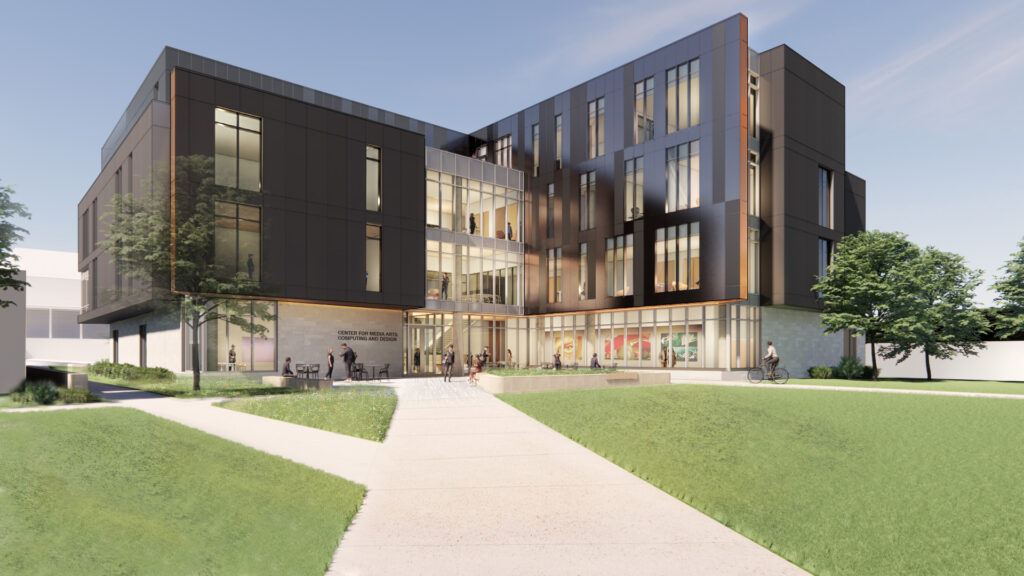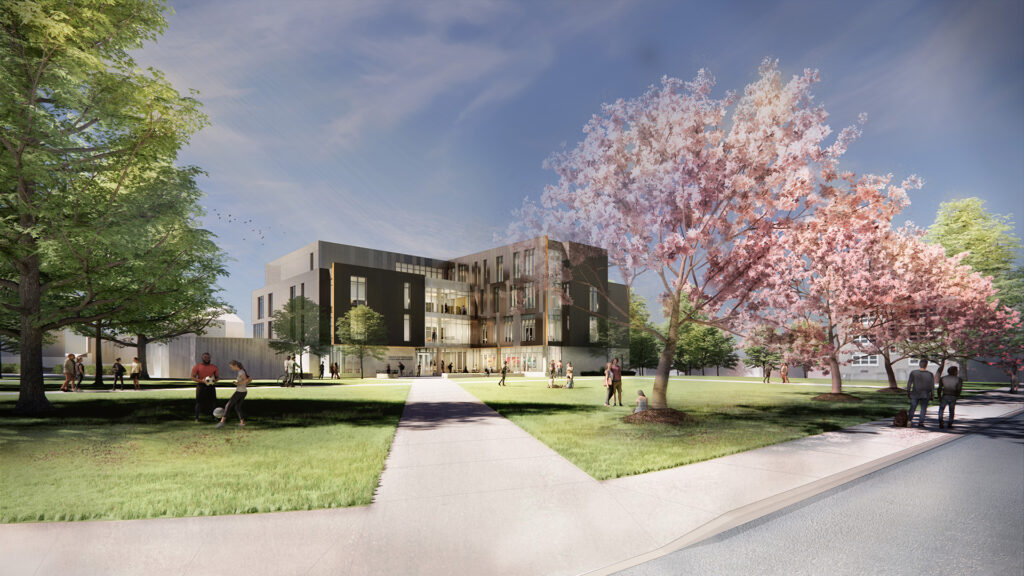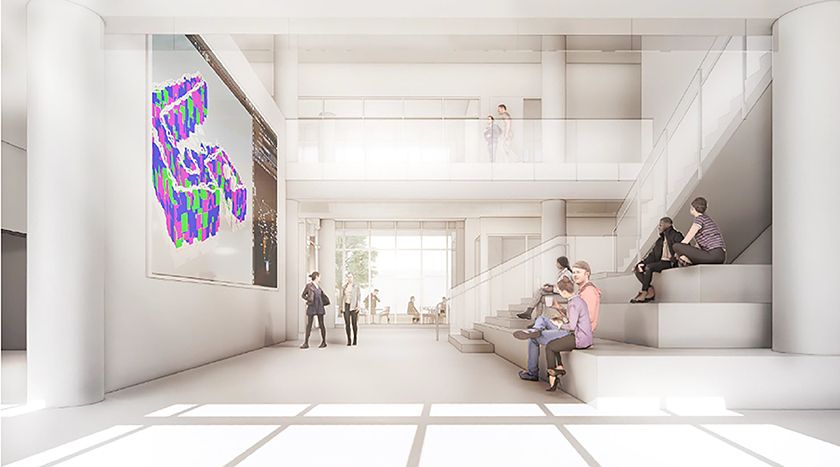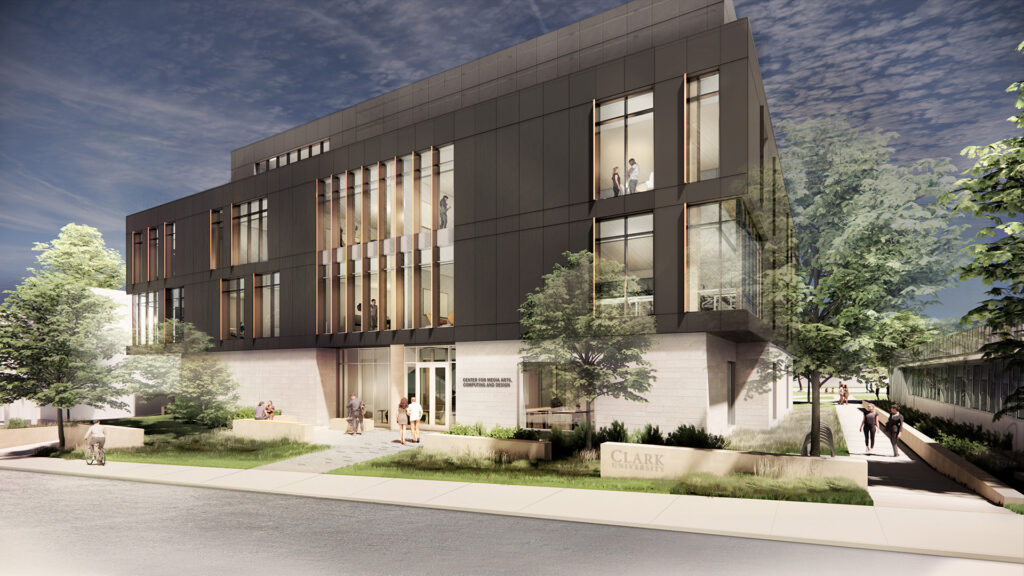New interdisciplinary building at Clark will be a hub for innovation and collaboration

Plans for a new interdisciplinary academic building on the Clark University campus are progressing. Yesterday, University leaders shared with members of the community preliminary conceptual designs for the Center for Media Arts, Computing, and Design, which will serve as a hub for interdisciplinary learning, research, creativity, and innovation.

The Center for Media Arts, Computing, and Design (MACD), with a targeted opening of fall 2023, will become home to the Department of Computer Science, the Becker School of Design & Technology, and some programs within the Department of Visual and Performing Arts. The four-story, 70,000-square-foot building will be located just southeast of the Strassler Center, between Woodland and Hawthorne Streets, and its main entrance will be oriented in the direction of the Goddard Library. The layout of the building and grounds will form a new academic quadrangle, adding additional green space to the campus.
“The Center for Media Arts, Computing, and Design dramatically advances our efforts to develop, explore, and refine a number of areas of knowledge and study in original and interconnected ways,” says President David Fithian. “I’m thrilled not only by the possibilities that this dramatic addition to our campus represents for our students, faculty, and staff but by the statement it makes about the power of strategic and collaborative planning and concerted action at Clark.”

Among the building’s notable features are a multimedia gallery, augmented reality/virtual reality lab, video game library for researching interactive media and playing games, a makerspace, incubator space, robotics lab, and a data science lab.
“Bringing together Computer Science, Visual and Performing Arts, and the Becker School in areas where they all have synergy is key to the vision for this building,” says Provost Sebastián Royo. “The faculty have worked with the architects to design spaces that will leverage the intersection of these areas in a way that creates new opportunities for collaboration across the university in teaching, research, and innovation. This interdisciplinary facility will be open to all members of the Clark community and offer resources in digital media production, design technology, and data science.”
Additional program spaces in the building include a multifloor tiered classroom, new labs, teaching spaces, faculty offices, and collaboration spaces.
“These three departments sharing space is ideal,” says Paul Cotnoir, dean of the Becker School of Design & Technology at Clark. “Many of the students in computer science are interested in gaming, and many of our gaming students are interested in computer science.”
Benjamin Korstvedt, professor of music, chair of the Department of Visual and Performing Arts, and a member of the MACD steering committee, says the building opens “a whole new spectrum of possibilities” for Clark students.
“Music and image; music and video. All these things connect, so I think there’s going to be tremendous energy and opportunity for students to collaborate and create all sorts of interdisciplinary bridges,” says Korstvedt. “I’m very encouraged because the whole design team has actively sought out input from those of us involved with teaching and who will be working with students in the building. The things we’ve asked for have all been accommodated. I think that will pay off very, very well in the final design.”
The building will be laid out in two “wings,” which will be clad in a grid of metal panels of similar color but different finishes to create a rich, layered look. Floor-to-ceiling windows wrap the structure overlooking a newly landscaped quad. The window pattern on the façade that faces the campus has a geometrically composed window pattern, reminiscent of both the pixelization and binary structure of technology and digital design.
Ayers Saint Gross, an internationally recognized, employee-owned design firm is designing the building. The team has been working with Clark faculty and staff over the last few months to help envision the space. Ayers Saint Gross is also Clark’s partner on the comprehensive Campus Design Initiative, which offers a strategic blueprint for reimagining the University’s buildings and grounds.

“They took a drink from these huge firehoses every time they asked for opinions,” says Cotnoir of partnering with Ayers Saint Gross. “Now, they’ve taken all of that and distilled it into something really incredible.”
“An investment in a new facility such as this one,” President Fithian added, “is really an investment in Clark’s people. We have excellent academic programs because we have excellent students, faculty, and staff who, in turn, need great facilities to be able to do their very best work.”
The University is pursuing LEED Gold certification for “green” construction and operation and expects to rely primarily on geothermal wells to heat and cool the building.
“I think it’s going to be a very attractive and inviting building,” says Korstvedt. “It feels like this is starting an important new chapter in Clark’s ongoing story.”
Learn more about Clark University’s capital projects.


